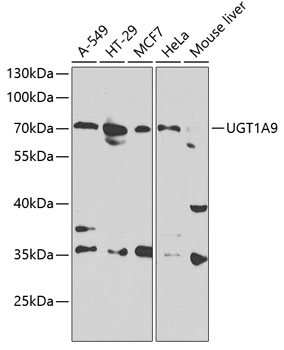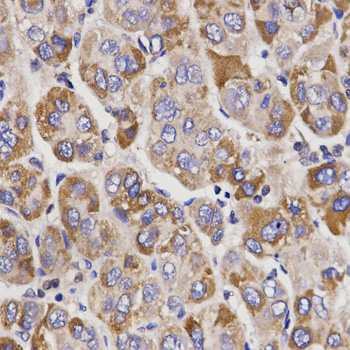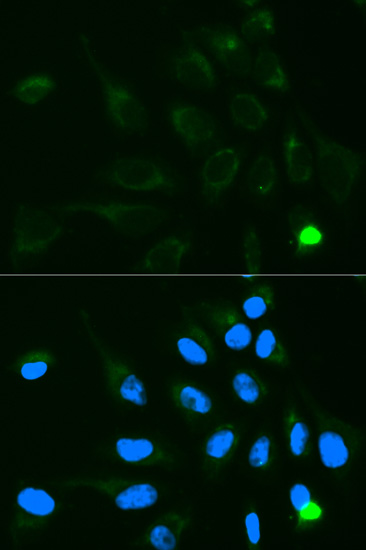-
Product Name
UGT1A9 Polyclonal Antibody
- Documents
-
Description
Polyclonal antibody to UGT1A9
-
Tested applications
WB, IHC, IF
-
Species reactivity
Human, Mouse, Rat
-
Alternative names
UGT1A9 antibody; HLUGP4 antibody; LUGP4 antibody; UDPGT antibody; UDPGT 1-9 antibody; UGT-1I antibody; UGT1-09 antibody; UGT1-9 antibody; UGT1.9 antibody; UGT1A9S antibody; UGT1AI antibody; UGT1I antibody; UDPGT1-9 antibody; UDP-glucuronosyltransferase 1-9 antibody
-
Isotype
Rabbit IgG
-
Preparation
Antigen: Recombinant fusion protein containing a sequence corresponding to amino acids 26-250 of human UGT1A9 (NP_066307.1).
-
Clonality
Polyclonal
-
Formulation
PBS with 0.02% sodium azide, 50% glycerol, pH7.3.
-
Storage instructions
Store at -20℃. Avoid freeze / thaw cycles.
-
Applications
WB 1:500 - 1:2000
IHC 1:50 - 1:200
IF 1:50 - 1:200 -
Validations

Western blot - UGT1A9 Polyclonal Antibody
Western blot analysis of extracts of various cell lines, using UGT1A9 antibody at 1:1000 dilution.Secondary antibody: HRP Goat Anti-Rabbit IgG (H+L) at 1:10000 dilution.Lysates/proteins: 25ug per lane.Blocking buffer: 3% nonfat dry milk in TBST.

Immunohistochemistry - UGT1A9 Polyclonal Antibody
Immunohistochemistry of paraffin-embedded human liver cancer using UGT1A9 antibody at dilution of 1:200 (40x lens).

Immunofluorescence - UGT1A9 Polyclonal Antibody
Immunofluorescence analysis of MCF-7 cells using UGT1A9 antibody . Blue: DAPI for nuclear staining.
-
Background
UDPGT is of major importance in the conjugation and subsequent elimination of potentially toxic xenobiotics and endogenous compounds. This isoform has specificity for phenols. Isoform 2 lacks transferase activity but acts as a negative regulator of isoform 1.
Related Products / Services
Please note: All products are "FOR RESEARCH USE ONLY AND ARE NOT INTENDED FOR DIAGNOSTIC OR THERAPEUTIC USE"
